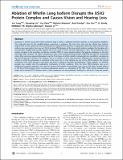| dc.contributor.author | Yang, Jun | |
| dc.contributor.author | Liu, Xiaoqing | |
| dc.contributor.author | Zhao, Yun | |
| dc.contributor.author | Adamian, Michael | |
| dc.contributor.author | Pawlyk, Basil | |
| dc.contributor.author | Sun, Xun | |
| dc.contributor.author | McMillan, D. Randy | |
| dc.contributor.author | Liberman, M. Charles | |
| dc.contributor.author | Li, Tiansen | |
| dc.date.accessioned | 2011-03-30T16:27:25Z | |
| dc.date.issued | 2010 | |
| dc.identifier.citation | Yang, Jun, Xiaoqing Liu, Yun Zhao, Michael Adamian, Basil Pawlyk, Xun Sun, D. Randy McMillan, M. Charles Liberman, and Tiansen Li. 2010. Ablation of whirlin long isoform disrupts the USH2 protein complex and causes vision and hearing loss. PLoS Genetics 6(5): e1000955. | en_US |
| dc.identifier.issn | 1553-7390 | en_US |
| dc.identifier.uri | http://nrs.harvard.edu/urn-3:HUL.InstRepos:4782651 | |
| dc.description.abstract | Mutations in whirlin cause either Usher syndrome type II (USH2), a deafness-blindness disorder, or nonsyndromic deafness. The molecular basis for the variable disease expression is unknown. We show here that only the whirlin long isoform, distinct from a short isoform by virtue of having two N-terminal PDZ domains, is expressed in the retina. Both long and short isoforms are expressed in the inner ear. The N-terminal PDZ domains of the long whirlin isoform mediates the formation of a multi-protein complex that includes usherin and VLGR1, both of which are also implicated in USH2. We localized this USH2 protein complex to the periciliary membrane complex (PMC) in mouse photoreceptors that appears analogous to the frog periciliary ridge complex. The latter is proposed to play a role in photoreceptor protein trafficking through the connecting cilium. Mice carrying a targeted disruption near the N-terminus of whirlin manifest retinal and inner ear defects, reproducing the clinical features of human USH2 disease. This is in contrast to mice with mutations affecting the C-terminal portion of whirlin in which the phenotype is restricted to the inner ear. In mice lacking any one of the USH2 proteins, the normal localization of all USH2 proteins is disrupted, and there is evidence of protein destabilization. Taken together, our findings provide new insights into the pathogenic mechanism of Usher syndrome. First, the three USH2 proteins exist as an obligatory functional complex in vivo, and loss of one USH2 protein is functionally close to loss of all three. Second, defects in the three USH2 proteins share a common pathogenic process, i.e., disruption of the PMC. Third, whirlin mutations that ablate the N-terminal PDZ domains lead to Usher syndrome, but non-syndromic hearing loss will result if they are spared. | en_US |
| dc.language.iso | en_US | en_US |
| dc.publisher | Public Library of Science | en_US |
| dc.relation.isversionof | doi:10.1371/journal.pgen.1000955 | en_US |
| dc.relation.hasversion | http://www.ncbi.nlm.nih.gov/pmc/articles/PMC2873905/pdf/ | en_US |
| dash.license | LAA | |
| dc.subject | cell biology | en_US |
| dc.subject | ophthalmology | en_US |
| dc.subject | retinal disorders | en_US |
| dc.title | Ablation of Whirlin Long Isoform Disrupts the USH2 Protein Complex and Causes Vision and Hearing Loss | en_US |
| dc.description.version | Version of Record | en_US |
| dc.relation.journal | PLoS Genetics | en_US |
| dash.depositing.author | Liberman, M. Charles | |
| dc.date.available | 2011-03-30T16:27:25Z | |
| dash.affiliation.other | HMS^Neurobiology | en_US |
| dash.affiliation.other | HMS^Ophthalmology | en_US |
| dash.affiliation.other | HMS^Otology and Laryngology | en_US |
| dash.affiliation.other | HMS^Medicine-Massachusetts General Hospital | en_US |
| dc.identifier.doi | 10.1371/journal.pgen.1000955 | * |
| dash.contributor.affiliated | Zhao, Yun | |
| dash.contributor.affiliated | Yang, Jun | |
| dash.contributor.affiliated | Pawlyk, Basil | |
| dash.contributor.affiliated | Liberman, M. | |


